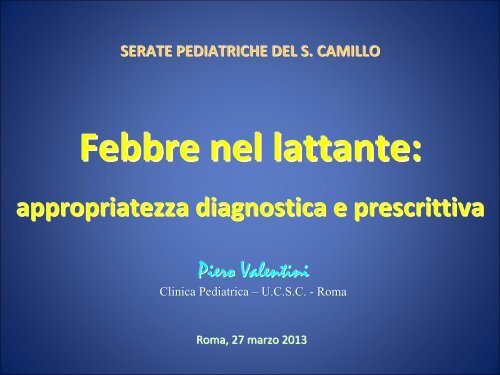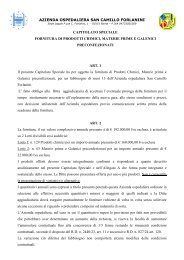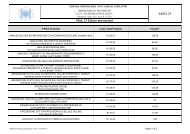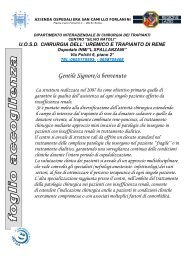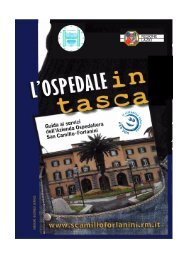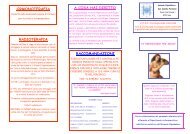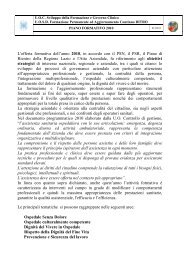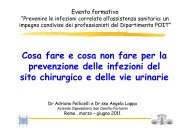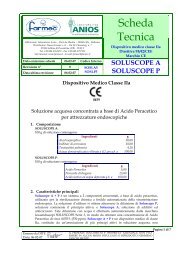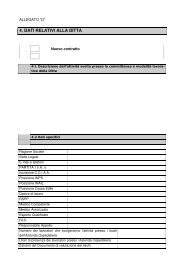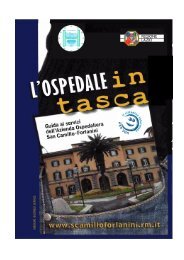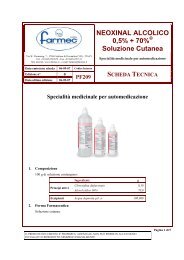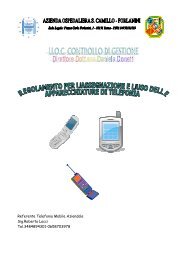La febbre nel lattante - Azienda ospedaliera S.Camillo-Forlanini
La febbre nel lattante - Azienda ospedaliera S.Camillo-Forlanini
La febbre nel lattante - Azienda ospedaliera S.Camillo-Forlanini
You also want an ePaper? Increase the reach of your titles
YUMPU automatically turns print PDFs into web optimized ePapers that Google loves.
SERATE PEDIATRICHE DEL S. CAMILLO<br />
Febbre <strong>nel</strong> <strong>lattante</strong>:<br />
appropriatezza diagnostica e prescrittiva<br />
Piero Valentini<br />
Clinica Pediatrica – U.C.S.C. - Roma<br />
Roma, 27 marzo 2013
A meta‐analysis<br />
analysis of studies published between 1974 and 1990 found<br />
that 7.2 percent of all children younger than 90 days with a rectal<br />
temperature higher than 102.2° F (39°C) had an SBI (serious<br />
bacterial infection).<br />
(Baskin MN. Pediatr Ann 1993;22:462‐6)<br />
6)<br />
Bacteremia or bacterial meningitis occurred in 2.5 percent of<br />
patients with an even higher incidence (8.7 to 13 percent) in infants<br />
younger than 29 days. (Baraff LJ, et al. Ann Emerg Med 1993;22:1198‐210<br />
2000;36:602‐14<br />
‐ Baker MD, Bell LM. Arch Pediatr Adolesc Med 1999;153:508‐11)<br />
11)<br />
210 ‐ Baraff LJ. Ann Emerg Med
MTS flowchart categorized into presenting problems<br />
Life<br />
threat<br />
Pain<br />
Hemorrage<br />
Temperature<br />
Signs<br />
and<br />
Symptoms<br />
+<br />
Acuteness<br />
of<br />
onset<br />
Consciousness<br />
level<br />
Van Ierland Y, et al. Pediatrics 2012;129:e643‐51
Toxic‐appearing<br />
children<br />
• Cyanosis<br />
• Decreased activity<br />
• Hyper‐ and hypoventilation<br />
• Inability to interact with parents or surroundings<br />
• Irritability<br />
• Lethargy<br />
• Poor tone<br />
• Signs of poor perfusion<br />
• Tachycardia<br />
• Weak eye contact<br />
Clin Pediatr (Phila) 2000;39:81‐8.‐ Ann Emerg Med 2000;36:602‐14 ‐JAMA 2004;291:1203‐12 ‐ Ann Emerg Med<br />
1993;22:1198‐210 ‐ N Engl J Med 1993;329:1437‐41 ‐ J Pediatr 1992;120:22‐7 – Pediatrics 1994;94:390‐6 –<br />
http://www.cincinnatichildrens.org/svc/alpha/h/health‐policy/ev‐based/fever‐2‐36‐months.htm.
Low risk children<br />
WBC 1,500 cells/mm 3 )<br />
(Jaskiewicz JA, et al. Pediatrics 1994;94:390‐6)<br />
Absolute neutrophil count (ANC) of ≥10,000 or more cells/mm 3<br />
predictive of SBI as a WBC count of >15,000 cells/mm 3<br />
Sensitivity: 69 percent<br />
.<br />
Specificity: 79 percent<br />
(Kuppermann N. Pediatr Clin North Am 1999;46:1073‐109)<br />
109)
Evaluating fever<br />
of<br />
unidentifiable<br />
source<br />
in young children<br />
Sur DK, Bukont EL.<br />
Am Fam Physician 2007;<br />
75:1805‐11<br />
11
Traffic light<br />
system<br />
for identifying<br />
risk of serious<br />
illness<br />
NICE, , 2007
NICE, , 2007
NICE, , 2007
NICE, , 2007
NICE, , 2007
NICE, , 2007
Algoritmo gestionale<br />
del<br />
bambino febbrile<br />
Nice, , 2007
Performance of the NICE traffic light system with and without urine u<br />
analysis for detection of serious bacterial infection.<br />
Values are percentage (95% confidence intervals)<br />
De S, et al. BMJ 2013;346:f866
De S, et al. BMJ 2013;346:f866
Comparison between parents’ and paediatricians’ answers<br />
Chiappini E, et al. BMC Pediatrics 2012; 12:97
Parental and medical knowledge and management of fever<br />
in Italian pre‐school children<br />
Chiappini E, et al. BMC Pediatrics 2012; 12:97
Beliefs regarding harmful effects<br />
reported by 388 parents<br />
Chiappini E, et al. BMC Pediatrics 2012; 12:97
Beliefs regarding<br />
possible highest degree of fever<br />
reported by 388 parents<br />
Chiappini E, et al. BMC Pediatrics 2012; 12:97
Beliefs regarding interval of fever monitoring<br />
reported by 388 parents<br />
Chiappini E, et al. BMC Pediatrics 2012; 12:97
Beliefs regarding resources of information<br />
reported by 388 parents<br />
Chiappini E, et al. BMC Pediatrics 2012; 12:97
Update of the 2009 Italian Pediatric Society<br />
Guidelines about management of fever in children<br />
‣ Axillary temperature measurement using a digital thermometer is recommended in<br />
children younger than 4 weeks (evidence level III; strength of recommendation,<br />
B). In the hospital or ambulatory care setting, axillary temperature measurement<br />
using a digital thermometer or an infrared thermometer (tympanic or with or without<br />
skin contact) is recommended in children older than 4 weeks (evidence level II;<br />
strength of recommendation, B). B<br />
‣ Paracetamol and ibuprofen are the only antipyretic drugs recommended ended for use in children<br />
(evidence level I; strength of recommendation, A). Combined or alternating use of<br />
ibuprofen and paracetamol is not recommended (evidence level VI; strength of<br />
recommendation, D).<br />
Chiappini E, et al. Clin Ther 2012;34(7):1648‐53
Linee guida per la Gestione del Segno/Sintomo<br />
Febbre in Pediatria ‐ Aggiornamento<br />
Paracetamolo e ibuprofene sono antipiretici generalmente sicuri ed<br />
efficaci che devono essere utilizzati a dosaggi standard:<br />
• paracetamolo:<br />
‐ 10‐15/mg/kg/dose 15/mg/kg/dose (massimo 1 g/dose) ogni 4‐64<br />
6 ore;<br />
‐ dosaggio terapeutico massimo 60 mg/kg/die <strong>nel</strong> bambino fino a 3<br />
mesi, 80 mg/kg/die <strong>nel</strong> bambino sopra a 3 mesi di età (massimo 3<br />
g/die);<br />
‐ dosaggio tossico >150 mg/kg in unica somministrazione.<br />
• ibuprofene:<br />
‐ 10 mg/kg/die (massimo 800 mg/dose) ogni 6‐86<br />
8 ore.<br />
‐ Dosaggio terapeutico massimo: 30 mg/kg/die (massimo 1,2 g/die);<br />
‐ dosaggio tossico >100 mg/kg/die. (livello(<br />
di prova: I; forza della<br />
raccomandazione A) A<br />
GS SIP per la Febbre in Pediatria
Sovradosaggio cronico di paracetamolo<br />
Dosaggi superiori a 15 mg/kg/dose o<br />
intervalli fra le somministrazioni inferiori alle 4 h<br />
(Curr Opin Pediatr 2012, 24:400–406)<br />
406)<br />
Uso degli antipiretici per le convulsioni febbrili<br />
L’impiego preventivo di paracetamolo o ibuprofene in bambini<br />
febbrili non previene le convulsioni febbrili, pertanto essi non<br />
devono essere utilizzati per questa finalità<br />
(livello di prova I; forza della raccomandazione E) E<br />
GS SIP per la Febbre in Pediatria
Uso di antibiotici (pubblico e privato) in<br />
Francia, Italia, Regno Unito e Germania<br />
(1999‐2007)<br />
ESAC Yearbook 2007
Uso SSN di antibiotici <strong>nel</strong>le Regioni<br />
Italiane in DDD/1000 ab/die<br />
Fonte: AIFA
Uso SSN di antibiotici <strong>nel</strong>le Regioni<br />
Italiane in DDD/1000 ab/die ‐2008<br />
Fonte: AIFA
Primi 20 principi attivi<br />
per consumo totale<br />
2008<br />
Fonte: AIFA
Prevalenza di pazienti con almeno una prescrizione di<br />
antibiotici, per numero di prescrizione, classi d’etd<br />
età e genere<br />
2008<br />
Fonte: AIFA
Rapporto sull’uso uso dei farmaci antibiotici<br />
Analisi del consumo territoriale <strong>nel</strong>le regioni italiane<br />
2009<br />
“L’uso inappropriato degli antibiotici <strong>nel</strong>le fasce di età<br />
pediatriche e sempre stato motivo di discussione a causa delle<br />
reazioni avverse ad essi correlate (dati della Rete Nazionale di<br />
Farmacovigilanza, RNF) ed alla eventuale loro interazione con<br />
altri farmaci somministrati.<br />
Secondo questi dati appare ancora evidente un uso improprio e<br />
non razionale di questi farmaci per indicazioni che non sempre<br />
risultano basate su evidenze scientifiche”<br />
Napoleone E. Il punto di vista del Pediatra del territorio
Factors of importance for medium/high<br />
level of concern about infectious illness in<br />
the family<br />
Malin A, et al. Fam Pract 2007
Percentage of physicians consultations and antibiotic<br />
prescription for the 18‐month<br />
month‐old old child<br />
during 1 month in the families in relation to<br />
concern about infectious illness<br />
)<br />
Malin A, et al. Fam Pract 2007
Association between overall consumption of medicines and sociodemographic,<br />
lifestyle and health profile variables (Spanish pediatric population<br />
≤ 15 years)<br />
SNHS ‘93<br />
Adjusted OR<br />
95% CI SNHS ‘03<br />
Adjusted OR<br />
95% CI<br />
Occupational<br />
status of<br />
interviewee<br />
Employed<br />
Unemployed<br />
Inactive<br />
1.00<br />
1.16<br />
1.70<br />
‐‐‐<br />
(0.86‐1.57)<br />
(1.13‐2.55)<br />
NS<br />
‐‐‐<br />
Sex of child<br />
Male<br />
Female<br />
1.00<br />
1.21<br />
‐‐‐<br />
(1.03‐1.42)<br />
1.42) NS ‐‐‐<br />
Self‐assessment<br />
of health status<br />
Very /good/good<br />
Fair/poor/very poor<br />
1.00<br />
2.84<br />
‐‐‐<br />
(2.16‐3.72)<br />
1.00<br />
3.54<br />
‐‐‐<br />
(2.74‐4.56)<br />
4.56)<br />
Medical<br />
consultation<br />
No<br />
Yes<br />
1.00<br />
12.09<br />
‐‐‐<br />
(10.13‐14.42)<br />
14.42)<br />
1.00<br />
7.17<br />
‐‐‐<br />
(6.06‐8.47)<br />
Hospitalization<br />
in preceding 12<br />
months<br />
No<br />
Yes<br />
NS ‐‐‐<br />
1.00<br />
1.48<br />
‐‐‐<br />
(1.05‐2.08)<br />
Emerging visit in<br />
preceding 12<br />
months<br />
No<br />
Yes<br />
NS ‐‐‐<br />
1.00<br />
1.49<br />
‐‐‐<br />
(1.26‐1.75)<br />
1.75)<br />
Carrasco‐Garrido P, et al. Br J Clin Pharmacol 2009
Le ragioni di un successo:<br />
il calo del consumo di antibiotici in Francia<br />
A livelli epidemici costanti il consumo invernale di antibiotici si è<br />
ridotto in Francia del 23,4% dall’inizio del programma (dall’inverno<br />
2001‐2002 2002 all’inverno 2006‐2007).<br />
2007).<br />
L’obiettivo di un 25% di riduzione in cinque anni, fissato <strong>nel</strong> 2002,<br />
2, è<br />
stato dunque quasi completamente raggiunto e <strong>nel</strong> corso dei cinque<br />
anni sono stati evitati circa 26,8 milioni di trattamenti con antibiotici.<br />
In media la riduzione nei consumi è stata di circa il 4,5% per anno ed<br />
appare particolarmente importante in età pediatrica (‐34%(<br />
tra l’inverno l<br />
2001‐2002 2002 e l’inverno l<br />
2006‐2007)<br />
2007)<br />
Gouello M, Marty C. In “Rapporto sull’uso uso dei farmaci antibiotici .<br />
Analisi del consumo territoriale <strong>nel</strong>le regioni italiane 2009”
Delayed Prescription May Reduce the Use of<br />
Antibiotics for Acute Otitis Media.<br />
A Prospective Observational Study in Primary Care<br />
Of the 1099 children who were eligible for symptomatic treatment<br />
only, 743 (67.6%) recovered without antibiotic treatment at 3 days<br />
and 716 (65.1%) at 30 days.<br />
Marchetti F, et al. Arch Pediatr Adolesc Med. . 2005;159:679‐684<br />
684<br />
Wait‐and<br />
and‐See Prescription for the Treatment<br />
of Acute Otitis Media<br />
A Randomized Controlled Trial<br />
Within the WASP group, both fever (relative risk [RR], 2.95; 95% confidence<br />
interval [CI], 1.75 ‐ 4.99; P.001) and otalgia (RR, 1.62; 95% CI, 1.26 ‐ 2.03;<br />
P.001) were associated with filling the prescription.<br />
Spiro D M, et al. JAMA. 2006;296:1235‐1241<br />
1241
Riassumiamo….<br />
• Partire sempre e comunque dalla valutazione clinica attenta,<br />
magari aiutandosi con gli score presenti in letteratura<br />
• Maggiore “aggressività”<br />
nei confronti dei più piccoli<br />
• Chiedere aiuto alla diagnostica di laboratorio, in relazione alla<br />
sintomatologia, <strong>nel</strong>le situazioni ambigue e nei bambini più<br />
grandi<br />
• Limitare l’uso l<br />
degli antibiotici ai quadri più definiti o non<br />
autorisolventesi<br />
…dando<br />
il via alla discussione


